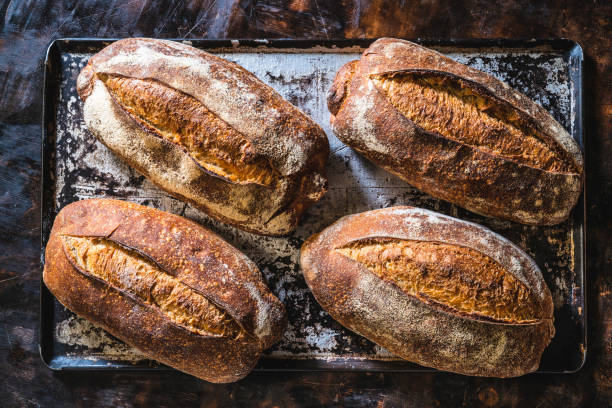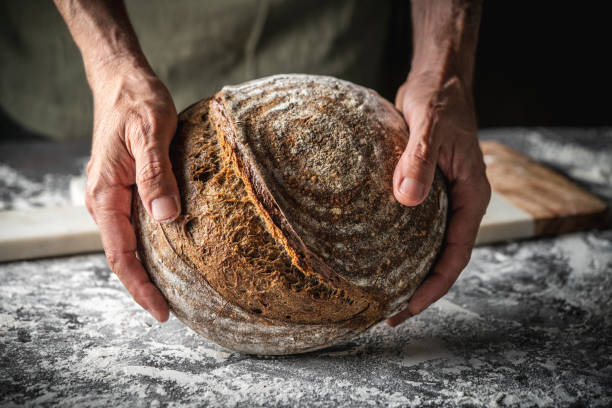Making it at home isn’t complicated, but it sure isn’t instant. The proofing bowl for bread—yeah, that little wicker basket thing—turns into your best friend. It keeps the dough shape, lets it breathe, gives that signature swirl pattern. First time you flip your dough out of it, you’ll grin like a fool. Trust me.
There’s something almost rebellious about baking your first homemade sour dough bread. No shortcuts. No instant yeast. Just flour, water, salt, and time doing its thing. The crust sings when it cools. The inside is chewy, tangy, alive. And then you’re stuck. Because once you’ve tasted real sourdough, store-bought bread feels like a sad sponge.
Why Proofing Bowl for Bread Is Not Optional
I’ll be blunt. You can try proofing in a random mixing bowl. You’ll end up with a lopsided, flat blob. It happens. Dough is alive—it spreads. A proofing bowl (also called banneton) keeps it snug, supports its rise, and adds that rustic texture. And if you’re into Instagram-worthy bread shots? Forget it without one.
The linen liner inside stops dough from sticking like glue. Ever tried prying sticky dough out of a metal bowl? Not fun. A banneton fixes that. Honestly, it’s one of those cheap tools that separates a loaf that looks pro from something you’re embarrassed to serve.
Starter: The Wild Beast You Have to Tame
Sourdough starter isn’t yeast in a packet. It’s flour and water left to ferment with wild yeasts from the air. It bubbles, smells funky, sometimes sour, sometimes fruity. You’ve got to feed it daily like some moody pet. Ignore it, and it sulks, turns watery, smells like old socks.

But once it’s strong? Magic. That starter is the engine under the hood of your sour dough bread. And when you combine a healthy starter with a proofing bowl for bread, you’re suddenly running with the big dogs.
The Slow Rise is Everything
You can’t rush sourdough. That slow fermentation is where flavor lives. Twelve hours, eighteen hours—it feels like forever. But when that loaf hits the oven, every hour pays you back with flavor. That tang, that chew, that crust that shatters under your knife.
The proofing bowl holds your dough in place while it dreams and stretches. That’s where gluten builds strength, where bubbles expand. If you cheat on this part, you’re left with dense bricks. Sourdough teaches patience, whether you like it or not.
The Texture: Chewy, Tangy, Alive
Here’s the thing: sour dough bread isn’t perfect. Holes are uneven, crust gets dark, sometimes it bursts in weird places. And that’s exactly the point. Real bread is alive. It’s not factory pressed. That chewy bite? Comes from slow gluten development. The tang? That’s the starter showing off.
And the structure? Thank your proofing bowl. Without it, your dough would spread into a sad pancake. It’s the mold, the cocoon, that gives the bread its backbone.
Don’t Overthink the Flour
People obsess over flours. “Oh, you need artisan stone-ground heritage wheat from a farm in France.” Stop. You can start with plain old all-purpose. Whole wheat is great for flavor. Rye gives extra sour kick. But don’t let fancy blogs scare you off.
Use what you’ve got. The real work comes from the starter and the proofing process. And yes, that means your proofing bowl again. Flour type matters less than how you treat your dough.
The Crust That Wakes You Up
When you pull that loaf from the oven and hear it crackle, you’ll know. That blistered, caramelized crust is your trophy. It’s what makes sourdough different from the limp stuff at the store. And it comes from steam, heat, and letting the dough proof properly.
The proofing bowl helps the outside dry just enough so it scores well and blooms in the oven. No proofing bowl, no proper bloom. You’ll get weird splits, flat tops. Don’t skip it.
Tools That Actually Matter
You don’t need a kitchen full of gadgets. But a few things matter: a scale (cups lie), a razor blade for scoring, a Dutch oven for baking, and a proofing bowl for bread. That’s it. The rest? Optional fluff.

I’ve seen people blow hundreds on gear and still bake sad loaves. Meanwhile, one good banneton and a cast iron pot can turn out world-class bread. Invest smart.
The Smell of Home
Nothing compares. When sourdough bakes, the smell drifts through the house—nutty, tangy, warm. Neighbors notice. Your kids wander into the kitchen. Even the dog waits by the oven. That smell alone is worth every feeding, every sticky mess, every long wait.
And when you finally slice into it? That’s the payoff. Proofing bowl, starter, oven—all working together to make something simple but unforgettable.
Common Screw-Ups You’ll Probably Make
Don’t panic if your first loaf is ugly. Happens to everyone. Overproofing makes it collapse. Underproofing keeps it dense. Dough sticks to the bowl. Crust burns. We’ve all been there.
The trick? Keep baking. Use your proofing bowl every time, learn how the dough feels under your hands, and adjust. You’ll mess up less each round. And the bread still tastes good, even if it looks wild.
Why Homemade Beats Store-Bought Every Time
It’s not even close. Store bread is pumped with preservatives, dough conditioners, sugar. It’s made to last, not to taste. Homemade sour dough bread is alive, honest, no junk. And when you bake it yourself, you control everything.
That control, paired with the simple help of a proofing bowl for bread, means you get the real deal every time. Bread with soul. Bread that reminds you food can be more than filler.
Passing It Down
Baking sourdough feels old. Ancient. Like you’re tapping into something bigger than yourself. People have been doing this for thousands of years. Starters get passed down generations, like family heirlooms. Your proofing bowl? It’s just a tool, but it ties you into that chain.
Bake enough loaves, and one day your kids will remember the smell. The crackle. Maybe they’ll grab that same banneton and carry it forward. And that’s what it’s really about.

Conclusion: Your First Loaf Starts Here
So here’s the truth—homemade sour dough bread isn’t hard. It’s just slow, messy, and stubborn. But with a healthy starter, some patience, and the right proofing bowl for bread, you’ll bake loaves that make everything else taste like cardboard.
Ready to try? Don’t wait. Grab your starter, grab a banneton, and jump in. Visit Abioto Baking to start your own sourdough journey today.
FAQs
Q: Do I really need a proofing bowl for bread?
A: You can try without, but your dough will flatten. A proofing bowl gives structure, air, and that rustic swirl.
Q: How long should sourdough proof?
A: Depends on room temp. Anywhere from 8–18 hours. Too short = dense. Too long = collapsed.
Q: What’s the best flour for homemade sour dough bread?
A: Start with all-purpose. Mix in whole wheat or rye once you’re comfortable.
Q: Can I bake sourdough without a Dutch oven?
A: Yes, but you’ll miss out on the steam effect that makes crust amazing.
Q: Why does my sourdough taste bland?
A: Usually weak starter or too short a proof. Feed your starter more often and give dough time.

